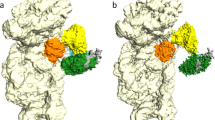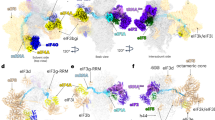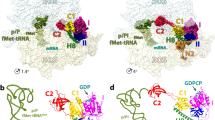Abstract
The universally conserved eukaryotic initiation factor (eIF) 5B, a translational GTPase, is essential for canonical translation initiation. It is also required for initiation facilitated by the internal ribosomal entry site (IRES) of hepatitis C virus (HCV) RNA. eIF5B promotes joining of 60S ribosomal subunits to 40S ribosomal subunits bound by initiator tRNA (Met-tRNAiMet). However, the exact molecular mechanism by which eIF5B acts has not been established. Here we present cryo-EM reconstructions of the mammalian 80S–HCV-IRES–Met-tRNAiMet–eIF5B–GMPPNP complex. We obtained two substates distinguished by the rotational state of the ribosomal subunits and the configuration of initiator tRNA in the peptidyl (P) site. Accordingly, a combination of conformational changes in the 80S ribosome and in initiator tRNA facilitates binding of the Met-tRNAiMet to the 60S P site and redefines the role of eIF5B as a tRNA-reorientation factor.
This is a preview of subscription content, access via your institution
Access options
Subscribe to this journal
Receive 12 print issues and online access
$189.00 per year
only $15.75 per issue
Buy this article
- Purchase on Springer Link
- Instant access to full article PDF
Prices may be subject to local taxes which are calculated during checkout






Similar content being viewed by others
References
Aitken, C.E. & Lorsch, J.R. A mechanistic overview of translation initiation in eukaryotes. Nat. Struct. Mol. Biol. 19, 568–576 (2012).
Pestova, T.V. et al. The joining of ribosomal subunits in eukaryotes requires eIF5B. Nature 403, 332–335 (2000).
Choi, S.K., Lee, J.H., Zoll, W.L., Merrick, W.C. & Dever, T.E. Promotion of met-tRNAiMet binding to ribosomes by yIF2, a bacterial IF2 homolog in yeast. Science 280, 1757–1760 (1998).
Wilson, S.A. et al. Cloning and characterization of hIF2, a human homologue of bacterial translation initiation factor 2, and its interaction with HIV-1 matrix. Biochem. J. 342, 97–103 (1999).
Carrera, P. et al. VASA mediates translation through interaction with a Drosophila yIF2 homolog. Mol. Cell 5, 181–187 (2000).
Strunk, B.S., Novak, M.N., Young, C.L. & Karbstein, K. A translation-like cycle is a quality control checkpoint for maturing 40S ribosome subunits. Cell 150, 111–121 (2012).
Pestova, T.V. et al. Molecular mechanisms of translation initiation in eukaryotes. Proc. Natl. Acad. Sci. USA 98, 7029–7036 (2001).
Roll-Mecak, A., Cao, C., Dever, T.E. & Burley, S.K. X-ray structures of the universal translation initiation factor IF2/eIF5B: conformational changes on GDP and GTP binding. Cell 103, 781–792 (2000).
Unbehaun, A. et al. Position of eukaryotic initiation factor eIF5B on the 80S ribosome mapped by directed hydroxyl radical probing. EMBO J. 26, 3109–3123 (2007).
Pisarev, A.V. et al. Specific functional interactions of nucleotides at key –3 and +4 positions flanking the initiation codon with components of the mammalian 48S translation initiation complex. Genes Dev. 20, 624–636 (2006).
Lee, J.H., Choi, S.K., Roll-Mecak, A., Burley, S.K. & Dever, T.E. Universal conservation in translation initiation revealed by human and archaeal homologs of bacterial translation initiation factor IF2. Proc. Natl. Acad. Sci. USA 96, 4342–4347 (1999).
Lee, J.H. et al. Initiation factor eIF5B catalyzes second GTP-dependent step in eukaryotic translation initiation. Proc. Natl. Acad. Sci. USA 99, 16689–16694 (2002).
Shin, B.S. et al. Uncoupling of initiation factor eIF5B/IF2 GTPase and translational activities by mutations that lower ribosome affinity. Cell 111, 1015–1025 (2002).
Pestova, T.V., de Breyne, S., Pisarev, A.V., Abaeva, I.S. & Hellen, C.U. eIF2-dependent and eIF2-independent modes of initiation on the CSFV IRES: a common role of domain II. EMBO J. 27, 1060–1072 (2008).
Terenin, I.M., Dmitriev, S.E., Andreev, D.E. & Shatsky, I.N. Eukaryotic translation initiation machinery can operate in a bacterial-like mode without eIF2. Nat. Struct. Mol. Biol. 15, 836–841 (2008).
Locker, N., Easton, L.E. & Lukavsky, P.J. HCV and CSFV IRES domain II mediate eIF2 release during 80S ribosome assembly. EMBO J. 26, 795–805 (2007).
Lukavsky, P.J. Structure and function of HCV IRES domains. Virus Res. 139, 166–171 (2009).
Pestova, T.V., Borukhov, S.I. & Hellen, C.U. Eukaryotic ribosomes require initiation factors 1 and 1A to locate initiation codons. Nature 394, 854–859 (1998).
Allen, G.S., Zavialov, A., Gursky, R., Ehrenberg, M. & Frank, J. The cryo-EM structure of a translation initiation complex from Escherichia coli. Cell 121, 703–712 (2005).
Myasnikov, A.G. et al. Conformational transition of initiation factor 2 from the GTP- to GDP-bound state visualized on the ribosome. Nat. Struct. Mol. Biol. 12, 1145–1149 (2005).
Shin, B.S. et al. rRNA suppressor of a eukaryotic translation initiation factor 5B/initiation factor 2 mutant reveals a binding site for translational GTPases on the small ribosomal subunit. Mol. Cell. Biol. 29, 808–821 (2009).
Fernández, I.S. et al. Molecular architecture of a eukaryotic translational initiation complex. Science 342, 1240585 (2013).
Loerke, J., Giesebrecht, J. & Spahn, C.M. Multiparticle cryo-EM of ribosomes. Methods Enzymol. 483, 161–177 (2010).
Scheres, S.H. & Chen, S. Prevention of overfitting in cryo-EM structure determination. Nat. Methods 9, 853–854 (2012).
Budkevich, T. V. et al. Regulation of the mammalian elongation cycle by 40S subunit rolling: a eukaryotic specific ribosome rearrangement. Cell 158, 121–131 (2014).
Hashem, Y. et al. Hepatitis-C-virus-like internal ribosome entry sites displace eIF3 to gain access to the 40S subunit. Nature 503, 539–543 (2013).
Unbehaun, A., Borukhov, S.I., Hellen, C.U. & Pestova, T.V. Release of initiation factors from 48S complexes during ribosomal subunit joining and the link between establishment of codon-anticodon base-pairing and hydrolysis of eIF2-bound GTP. Genes Dev. 18, 3078–3093 (2004).
Budkevich, T. et al. Structure and dynamics of the mammalian ribosomal pretranslocation complex. Mol. Cell 44, 214–224 (2011).
Guillon, L., Schmitt, E., Blanquet, S. & Mechulam, Y. Initiator tRNA binding by e/aIF5B, the eukaryotic/archaeal homologue of bacterial initiation factor IF2. Biochemistry 44, 15594–15601 (2005).
Ratje, A.H. et al. Head swivel on the ribosome facilitates translocation by means of intra-subunit tRNA hybrid sites. Nature 468, 713–716 (2010).
Spahn, C.M. et al. Domain movements of elongation factor eEF2 and the eukaryotic 80S ribosome facilitate tRNA translocation. EMBO J. 23, 1008–1019 (2004).
Kuhle, B. & Ficner, R. eIF5B employs a novel domain release mechanism to catalyze ribosomal subunit joining. EMBO J. 33, 1177–1191 (2014).
Spahn, C.M.T. et al. Hepatitis C virus IRES RNA-induced changes in the conformation of the 40S ribosomal subunit. Science 291, 1959–1962 (2001).
Filbin, M.E., Vollmar, B.S., Shi, D., Gonen, T. & Kieft, J.S. HCV IRES manipulates the ribosome to promote the switch from translation initiation to elongation. Nat. Struct. Mol. Biol. 20, 150–158 (2013).
Sprang, S.R. G protein mechanisms: insights from structural analysis. Annu. Rev. Biochem. 66, 639–678 (1997).
Voorhees, R.M. & Ramakrishnan, V. Structural basis of the translational elongation cycle. Annu. Rev. Biochem. 82, 203–236 (2013).
Connell, S.R. et al. Structural basis for interaction of the ribosome with the switch regions of GTP-bound elongation factors. Mol. Cell 25, 751–764 (2007).
Villa, E. et al. Ribosome-induced changes in elongation factor Tu conformation control GTP hydrolysis. Proc. Natl. Acad. Sci. USA 106, 1063–1068 (2009).
Hiraishi, H. et al. Interaction between 25S rRNA A loop and eukaryotic translation initiation factor 5B promotes subunit joining and ensures stringent AUG selection. Mol. Cell. Biol. 33, 3540–3548 (2013).
Acker, M.G. et al. Kinetic analysis of late steps of eukaryotic translation initiation. J. Mol. Biol. 385, 491–506 (2009).
Marshall, R.A., Aitken, C.E. & Puglisi, J.D. GTP hydrolysis by IF2 guides progression of the ribosome into elongation. Mol. Cell 35, 37–47 (2009).
Shin, B.S. et al. Structural integrity of α-helix H12 in translation initiation factor eIF5B is critical for 80S complex stability. RNA 17, 687–696 (2011).
Lomakin, I.B. & Steitz, T.A. The initiation of mammalian protein synthesis and mRNA scanning mechanism. Nature 500, 307–311 (2013).
Budkevich, T.V., El′skaya, A.V. & Nierhaus, K.H. Features of 80S mammalian ribosome and its subunits. Nucleic Acids Res. 36, 4736–4744 (2008).
Namy, O., Moran, S.J., Stuart, D.I., Gilbert, R.J. & Brierley, I. A mechanical explanation of RNA pseudoknot function in programmed ribosomal frameshifting. Nature 441, 244–247 (2006).
Suloway, C. et al. Automated molecular microscopy: the new Leginon system. J. Struct. Biol. 151, 41–60 (2005).
Mindell, J.A. & Grigorieff, N. Accurate determination of local defocus and specimen tilt in electron microscopy. J. Struct. Biol. 142, 334–347 (2003).
Chen, J.Z. & Grigorieff, N. SIGNATURE: A single-particle selection system for molecular electron microscopy. J. Struct. Biol. 157, 168–173 (2007).
Frank, J. et al. SPIDER and WEB: processing and visualization of images in 3D electron microscopy and related fields. J. Struct. Biol. 116, 190–199 (1996).
Penczek, P.A., Frank, J. & Spahn, C.M. A method of focused classification, based on the bootstrap 3D variance analysis, and its application to EF-G-dependent translocation. J. Struct. Biol. 154, 184–194 (2006).
Hohn, M. et al. SPARX, a new environment for cryo-EM image processing. J. Struct. Biol. 157, 47–55 (2007).
Yang, Z. & Penczek, P.A. Cryo-EM image alignment based on nonuniform fast Fourier transform. Ultramicroscopy 108, 959–969 (2008).
Emsley, P., Lohkamp, B., Scott, W.G. & Cowtan, K. Features and development of Coot. Acta Crystallogr. D Biol. Crystallogr. 66, 486–501 (2010).
Keating, K.S. & Pyle, A.M. RCrane: semi-automated RNA model building. Acta Crystallogr. D Biol. Crystallogr. 68, 985–995 (2012).
Selmer, M. et al. Structure of the 70S ribosome complexed with mRNA and tRNA. Science 313, 1935–1942 (2006).
Brunger, A.T. Version 1.2 of the Crystallography and NMR system. Nat. Protoc. 2, 2728–2733 (2007).
Laurberg, M. et al. Structural basis for translation termination on the 70S ribosome. Nature 454, 852–857 (2008).
Buchan, D.W., Minneci, F., Nugent, T.C., Bryson, K. & Jones, D.T. Scalable web services for the PSIPRED Protein Analysis Workbench. Nucleic Acids Res. 41, W349–W357 (2013).
Arnold, K., Bordoli, L., Kopp, J. & Schwede, T. The SWISS-MODEL workspace: a web-based environment for protein structure homology modelling. Bioinformatics 22, 195–201 (2006).
Acknowledgements
We thank T.V. Pestova (SUNY Downstate Medical Center) for expression vectors of eIF5B587–1220 (ΔeIF5B) and of Escherichia coli methionyl-tRNA synthetase, P. Lukavsky (ETH Zürich), for the HCV-IRES construct, T. Budkevich for help with tRNA purification, J. Ismer for help with modeling of the N-terminal part of eIF5B, C. Lally for proofreading of the manuscript and K. Yamamoto for helpful discussion. This work was supported by a grant from the German Research Foundation (DFG; SFB 740, Forschergruppe 1805) to C.M.T.S. A.U. acknowledges a Rahel Hirsch fellowship from the Charité Universitätsmedizin Berlin.
Author information
Authors and Affiliations
Contributions
A.U. and H.Y. established the in vitro system for the reconstitution of initiation complexes. H.Y. prepared the 80S–HCV-IRES–Met-tRNAiMet–eIF5B–GMPPNP complex. H.Y., J.B. and T.M. collected cryo-EM data. H.Y., J.L., E.B. and C.M.T.S. processed images. H.Y. and E.B. did the modeling. M.C. built the model of HCV-IRES RNA. H.Y., A.U. and C.M.T.S. discussed results and wrote the paper.
Corresponding author
Ethics declarations
Competing interests
The authors declare no competing financial interests.
Integrated supplementary information
Supplementary Figure 1 Multiparticle refinement for 80S–HCV-IRES–Met-tRNAiMet–eIF5B–GMPPNP complex.
Multi-particle refinement was used to overcome heterogeneity of the complex. The 541,570 particle images were analyzed with six-fold decimated data with a pixel size of 4.74 Å (pixel size (PS) 4.74), yielding one major population (267,528; 49 % of the complete data set). This population was further separated into three sub-populations using four-fold decimated data with a pixel size of 3.16 Å (PS 3.16). The population containing HCV IRES, tRNA and eIF5B (182,925; 33 %) was isolated. The isolated polupation was further split into structures correspoiding to a rolled (94,026; 16 %) and an unrolled state (88,899; 19 %). The focussed reassignment for ligands (eIF5B, P- and E-site tRNA) separated the dataset into 6 populations. Two populations (52,930; 9 % and 35,261; 6 %) identified by the absence of E-site tRNA were subsequently refined individually. The isolated populations representing substates I and II (34,388; 6 % and 24,777; 4 %, respectively) from three-fold decimated data with a pixel size of 2.37 Å (PS 2.37) were considered as final maps. No apparent density is present for eIF3, which is known to be released during eIF5B-promoted subunit joining on 80S initiation complexes on cellular and HCV-IRES mRNAs16-18.
Supplementary Figure 2 Resolution curves of the Pre- and Post-like complexes.
Resolution curves for the cryo-EM maps of the PRE-like and POST-like complex of the 80S•HCV-IRES•Met-tRNAi Met•eIF5B•GMPPNP initiation complex. The final resolution for the PRE- and POST-like complex is (a) 8.9 and 9.5 Å, respectively and was estimated using a cutoff of 0.5 in the Fourier shell correlation (FSC) standard curves, (b) 8.2 Å and 8.6 Å using with gold-standard approach using the 0.143 FSC criteria.
Supplementary Figure 3 Conformational change in tRNA upon binding by eIF5B on the ribosome.
(a) Superpostion of PI and P/P tRNAs in a common 40S alignment of the PRE-like state. Experimental map (semi-transparent green and red for tRNA and eIF5B map, respectively) with docked models of PI-tRNA, green and eIF5B domain IV, red), P/P-tRNA from POST state (PDB code 4CXB)19 (gray mesh map and model). (b) Comparison of the PRE-like state (colour) and 40S subunit from the yeast initiation 80S complex (EMD-2422)20 (gray) in a common 60S alignment. (c) Comparison of the Met-tRNAiMet•eIF5B•GMPPNP complex (colored as above) within the mammalian PRE-like state and the yeast initiation 80S complex (gray) (PDB code 4BYX) in a common large subunit alignment.
Supplementary Figure 4 The interaction of the G domain, switch I and domain IV of eIF5B with the ribosome.
The observed interactions are presented as density with fitted models. (a,c,e,g) PRE-like state, (b,d,f,h) POST like state: reconstructed cryo EM density is presented as gray mesh and docked models in color: GMPPNP (cyan), eIF5B (red), 28S rRNA (blue), 60S proteins (orange), 18S rRNA (yellow), 40S proteins (gray).
Supplementary Figure 5 Subunit association of vacant 40S and 60S subunits in the presence or absence of eIF5B.
(a and b) 40S and 60S subunits were incubated without eIF5B or in the presence of eIF5B587-1220 (eIFΔ5B), GTP or GMPPNP, as indicated. Assembly of 80S complexes was analyzed by sucrose gradient centrifugation and continuous OD measurement at 260 nm. The position of 80S complexes, 40S and free 60S subunits are indicated and were identified by comparison with control runs (data not shown). In the presence of eIFΔ5B and GTP or GMPPNP, the position of the peak of free 40S subunit is slightly shifted to the heavier fractions. Subunit joining and gradient centrifugation were performed at physiological and elevated concentration of MgCl2 (a: 2.5 mM MgCl2;b: 5 mM MgCl2).
Supplementary information
Supplementary Text and Figures
Supplementary Figures 1–5, Supplementary Table 1 and Supplementary Note (PDF 72835 kb)
Rights and permissions
About this article
Cite this article
Yamamoto, H., Unbehaun, A., Loerke, J. et al. Structure of the mammalian 80S initiation complex with initiation factor 5B on HCV-IRES RNA. Nat Struct Mol Biol 21, 721–727 (2014). https://doi.org/10.1038/nsmb.2859
Received:
Accepted:
Published:
Issue Date:
DOI: https://doi.org/10.1038/nsmb.2859
This article is cited by
-
The molecular basis of translation initiation and its regulation in eukaryotes
Nature Reviews Molecular Cell Biology (2024)
-
Structures of the eukaryotic ribosome and its translational states in situ
Nature Communications (2022)
-
Structural basis for the transition from translation initiation to elongation by an 80S-eIF5B complex
Nature Communications (2020)
-
Viral RNA structure-based strategies to manipulate translation
Nature Reviews Microbiology (2019)
-
Eukaryotic initiation factor 5B (eIF5B) provides a critical cell survival switch to glioblastoma cells via regulation of apoptosis
Cell Death & Disease (2019)



